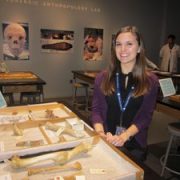What to see at a Smithsonian Affiliate in your neighborhood
It’s the Friday before Thanksgiving break. We’re all excited about seeing friends and family and taking a little break from school and work. So here are a few ideas for including the Smithsonian in your holiday plans from our Affiliate partners across the country:
Midwest
The Lizzadro Museum of Lapidary Art in Elmhurt, Illinois, hosts Modern Designer Jewelry from the Smithsonian, an exhibition that features jewelry from American Jewelry designers from 1960 to 2009 from the collections of the National Museum of Natural History.
Mid-Atlantic
Take an in-depth look at Pennsylvania’s significant role during the Civil War at the Senator John Heinz History Center in Pittsburgh. In its new major exhibition, Pennsylvania’s Civil War, you can find a tintype camera and portable printing press on loan from the National Museum of American History.
Mountain Plains
More than 21 artifacts on loan from the National Air and Space Museum are on view at the New Mexico Museum of Space History in Alamagordo. Get an up-close look at an Apollo Boilerplate Command Module and see the training coveralls worn by New Mexico astronaut, Harrison Schmitt, the only scientist to walk on the moon.
If you’re in San Antonio, the Institute of Texan Cultures is currently displaying two exhibitions from the National Museum of the American Indian and organized for travel by the Smithsonian Institution Traveling Exhibition Service (SITES). Native Words, Native Warriors tells the story of soldiers from more than a dozen tribes who used their Native languages while in service in the U.S. military. Ramp It Up: Skateboard Culture in Native America celebrates the vibrancy, creativity and history of American Indian skateboarding culture.
New England
It wouldn’t be Thanksgiving without the rich tradition of gathering together at harvest time and celebrating the abundant joys of the season. At Plimoth Plantation in Plymouth, Massachusetts, visitors can learn all about the settlement of the Plymouth Colony in the 17th century.
Southeast
Go on safari at the Schiele Museum of Natural History in Gastonia, North Carolina. Fourteen specimens–from a tiny eastern mole to a mountain gorilla–are on loan from the National Museum of Natural History.
The Polk Museum of Art in Lakeland, Florida, includes five works of art from the National Air and Space Museum collection in its exhibition Paintings of the Space Age.
The Mennello Museum of American Art in Orlando, Florida, has Earl Cunningham’s painting Seminole Indian Summer Camp on view from the Smithsonian American Art Museum in its Earl Cunningham gallery.

Seminole Indian Summer Camp, ca. 1963, Earl Cunningham, oil on fiberboard, Smithsonian American Art Museum, Gift of Michael and Marilyn Mennello.
West
Arizona State Museum, in Tucson, celebrates the creative work of American Indian directors, producers, writers, and actors during the Native Eyes Film Showcase, in collaboration with the National Museum of the American Indian and many others.
If you’re in California, visit the Japanese American National Museum in Los Angeles and see I Want the Wide American Earth: An Asian Pacific American Story. Created by the Smithsonian Asian Pacific American Center and organized for travel by SITES, the exhibit tells the story of how Asian Pacific Americans have shaped and been shaped by the course of our nation’s history.
Check out the San Diego Air and Space Museum where you can see nearly 30 space-related artifacts on loan from the National Air and Space Museum.
Is the Smithsonian in your neighborhood? Find an Affiliate here.




















